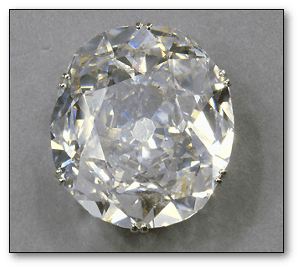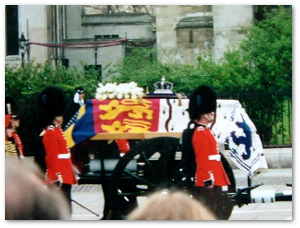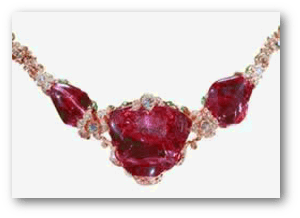A visitor to the British Crown Jewels exhibit must go to the Tower of London, where some powerful people have occasionally entered, against their will, and never exited alive.
The day I visited, back in the 1970s, the weather was gray and misty – an appropriate background for the executioner’s block that sat there and the huge ravens that loitered around it.
Impressed now with the gloomiest moments in British history, we tourists were then led into a very secure place within the white stone fortress, dark and hidden from public view (at that time the Jewel House was in the west wing of the Waterloo Barracks).
Down a spiraling walkway we went until we reached the point where darkness was broken by bright lights shining on a few showcases. Brilliant jewels behind the bulletproof glass of those cases, among them the Stars of Africa, the Koh-i-Noor Diamond, Prince Edward’s Ruby, and the Stuart and St. Edward sapphires, broke up the light into a thousand different colors and threw it back into our dazzled eyes.
Today the threat of nuclear war has receded and the British Crown Jewels are kept above ground. If you are ever in London, be sure to visit them to see these, some of the most famous gemstones in the world.
Famous diamonds
The First and Second Stars of Africa were both cut from the 3,106-carat Cullinan Diamond, the largest gem diamond ever found.

The pear-shaped First Star of Africa, sometimes called Cullinan I, is 530.2 carats. It is mounted in the Royal Scepter with Cross. The cushion-shaped Second Star (Cullinan II) is 317.4 carats and set into the Imperial Crown.
The Cullinan diamond was found in South African on January 26, 1905. In 1907, the Transvaal Legislature bought the stone from T. M. Cullinan and gave it to Britain’s King Edward VII, who promised that the diamond would be ““preserved among the historical jewels which form the heirlooms of the Crown.”
The Koh-i-noor diamond is the largest of all the diamonds that cover Queen Elizabeth I’s crown (the Queen Mum was Elizabeth I; the reigning monarch is Elizabeth II).

It has a much more contentious history than the Stars of Africa. The history of this Indian diamond before 1739 is unclear, but legend has it that it was discovered in a river thousands of years ago and worn by various leaders down through the millennia, changing hands several times as part of the spoils of war.

Nadir Shah, one of the Shahs of Iran, took the Koh-i-noor diamond when he conquered Delhi in 1739 and reportedly gave the gem its modern name, which means “Mountain of Light.” It remained in his family until the early 19th century, when Ranjit Singh seized it from Nadir Shah’s descendants after they came to him seeking help after being deposed.
Ranjit’s three sons inherited the Koh-i-noor Diamond in succession, but the last son handed it over to the British East India Company in 1849 as part of the peace treaty that ended the Anglo-Sikh Wars. It became part of the British Crown Jewels when Queen Victoria became Empress of India in 1877.
India and Pakistan have long sought unsuccessfully to have the Koh-i-noor returned. As recently as 2013, Prime Minister David Cameron said that the diamond will not be returned.
In 1852, the diamond was cut to its current 105.6-carat size. Victoria wore it as a brooch, and the queen consorts after her wore it in their own crown, which is smaller than the Imperial Crown.
Queen Elizabeth I wore this crown, minus the arches, to her daughter’s coronation in 1953, and it was set atop her casket during her funeral procession in 2002.

If the former Kate Middleton becomes queen consort to King William, she will wear this crown.
Famous sapphires
Two sapphires decorate the Imperial Crown.

St. Edward’s Sapphire, the oldest of the British Crown Jewels, possibly dating back to at least the 11th century, is set in the Maltese cross atop the crown. Its carat weight is unknown.
This gem has a rather gruesome history, at least to us moderns. Reportedly, Edward the Confessor, who eventually became Saint Edward, wore it as a ring during his coronation in 1042 A.D. It accompanied him to his grave in Westminster Abbey in 1066.
In 1269, King Henry III had Saint Edward’s grave opened so he could be moved to a new tomb. The body was well preserved, and they took Edward’s crown, ring, and other ornaments before re-burying him. To us, that’s grave robbing. To people at the time, it was honoring a saint. His ornaments were venerated by succeeding monarchs as symbols of divine power.
That is why, today, the only surviving piece belonging to Edward – the sapphire – sits in a cross at the very top of the greatest crown of the land.
The 104-carat Stuart Sapphire sits on the Imperial Crown like the Great Spot sits on the planet Jupiter.
Its history is bound up with that of England and Scotland.
Tradition has it that the sapphire was originally worn in the crown of Alexander II, King of Scots, during his coronation in 1214.
Then along came Edward Longshanks, who took both the sapphire and the Stone of Scone. This gemstone remained with the House of Plantagenet until it was given to Robert II, founder of Scotland’s House of Stuart, in the 14th century.
The last legitimate heir of the Stuarts then gave it to King George III in the late 18th or early 19th century, along with other Stuart relics.
Famous red gemstones
Two very famous “rubies” in the Crown Jewels – Prince Edward’s Ruby and the Timur Ruby – were found to be spinels in the 1850s (“Spinel is to ruby as Salieri is to Mozart,” says the founder of Jewelry Television).

The 352.5-carat Timur Ruby technically belongs to Queen Elizabeth II but is still considered part of the British Crown Jewels. It was once considered the biggest ruby in the world, until they found it to be spinel in 1851.
The Timur Ruby’s long history among various Indian rulers is complicated. Six of its owners inscribed their names and dates on this uncut gem, beginning with Timur in the 14th century (though this is being reconsidered) and ending with Ahmad Shah in 1754.
The East India Company acquired the Timur Ruby in the same 1849 treaty that brought them the Koh-i-noor Diamond. They presented the Timur Ruby to Queen Victoria in 1851, and she had it set into a necklace. After the Timur Ruby necklace was lengthened in 1911, it has never been worn.
At 170 carats, Prince Edward’s Ruby is the largest uncut spinel in the world. It surfaced in Europe as the property of Abu Said, prince of Grenada, during the Muslim occupation of the Iberian Peninsula. Don Pedro took it during the Reconquest and then gave it to Edward Woodstock, Prince of Wales (known as the Black Prince because of the color of his armor), in 1367 for the Englishman’s assistance in putting down a civil war.
The stone had apparently been drilled and used as a bead at some point. This drill hole was later filled in with real ruby.

The gem remained out of sight until 1415, when Henry V wore it at Agincourt. Richard III reportedly wore Prince Edward’s Ruby at Bosworth Field in 1485, where he was killed but the jewel was preserved. James I put the “ruby” into the state crown in 1603.
When Queen Victoria was crowned in 1838, she wore a new Imperial Crown that had over 3,000 gems. Prince Edward’s Ruby sat in a prominent position at the front of the crown above the Stuart Sapphire.

On my visit to the British Crown Jewels in 1973, I didn’t know the history of these stones. It was enough to enjoy their beauty, along with the other coronation regalia and precious jewels. Now, better prepared, perhaps I may someday be able to visit them again to enjoy them on a deeper level.
Edited December 30, 2022.
More information:
- The Crown Jewels. The British Monarchy website
- Black Prince Ruby. Shihaan Larif
- Stuart Sapphire. Shihaan Larif
- The Timur Ruby. Shihaan Larif
- The British Crown Jewels. The Natural Sapphire Company
- The Cullinan Diamond Centennial: A History and Gemological Analysis of Cullinans I and II (PDF). Kenneth Scarratt and Russell Shor
- Crown Jewels of the United Kingdom. Wikipedia
- Jewel House. Wikipedia
- Koh-i-Noor. Wikipedia
- Stewart Sapphire. Wikipedia



[…] the ones we’re interested in here are Cullinan I and Cullinan II, which ended up in the British crown jewels. The 530.2-carat […]
“The Koh-i-noor diamond is the largest of all the diamonds that cover Queen Elizabeth I’s crown (the Queen Mum was Elizabeth I; the reigning monarch is Elizabeth II).” !!?? No….
The present Queen Elizabeth II’s mother was not Elizabeth I. She reigned from 1558-1603. The present queen’s mother was a queen but not a number! She was wife of George VI (1936-1952) and after his death known as the Queen Mother.
[…] If you’re like me, “royal jewels” only means the British crown jewels. […]
[…] the ones we’re interested in here are Cullinan I and Cullinan II, which ended up in the British crown jewels. The 530.2-carat […]